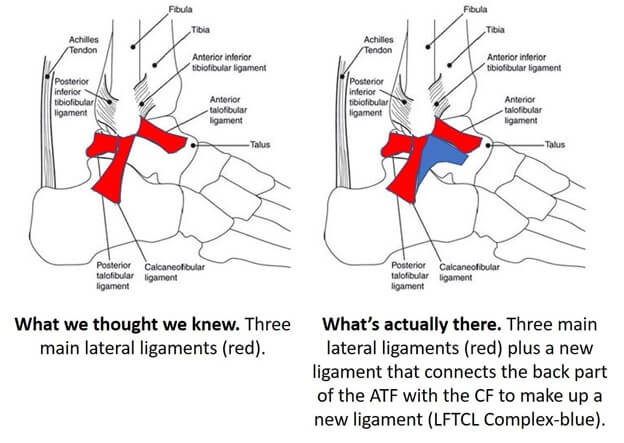In 2018, researchers at the University of Barcelona published their discovery of more complex ligament structures within the ankle joint than previously understood. This exciting new discovery may explain the persistence of ankle pain despite traditional medical treatment following an injury. In this article we will discuss this new research and explain how these discoveries bolster our long-practiced treatment approaches that we have found very successful for treating ankle instability.
The Lateral Ankle
Lateral ankle sprains account for nearly 85% of all ankle sprains.1 The Anterior Talo-Fibular Ligament (ATFL) complex is damaged in lateral ankle sprains. This ligament complex includes the ATFL, calcaneofibular ligament and the posterior talofibular ligaments. The anterior talofibular ligament specifically is the weakest ligament in this complex.
Once a lateral ankle sprain occurs, the risk of re-injury within a year increases by two-fold and these injuries are associated with long term chronic ankle instability, or CAI. The average age of the initial ankle injury is between 10-14 years for females and 15-19 years for males. Such injuries are typically athletic related. Quick inversion and internal rotation motions of the foot are responsible for these sprains.2
While dissecting ankle specimens, researchers at the University of Barcelona discovered that the upper portion of the ATFL complex was more expansive than what was previously understood. They learned that the ATFL is a more intra-articular ligament than previously believed. This means the ATFL is more inside of the joint capsule, than extrinsic, or outside of the joint capsule, as previously believed. This revelation helps to explain the future instability of patients’ ankles after first being injured. The lower portions of the ATFL complex that are extrinsic, or outside the capsule, develop scar tissue following an injury; however, the upper portions of the ATFL complex that are intra-articular do not develop scar tissue and therefore remain unhealed (Fig 1).
Treatment for Lateral Ankle Injury
At Oregon Regenerative Medicine we understand the dynamics of these ankle sprains and treat both the extrinsic, outside the joint capsule portions, of the ATFL complex as well as the upper, intracapsular portion of the ligament complex. Based on the severity of the injury, we may employ such treatment modalities of prolotherapy, or dextrose and lidocaine, platelet rich plasma or adipose derived mesenchymal stem cells. These treatment modalities in their own specific ways can assist with tightening up the ligament complex and assist with regenerating collagen inside the joint capsule. While reducing overall pain, this approach can dramatically improve long term stability.
Dr. Stacey Guggino, ND, LAc, graduated from the National College of Natural Medicine in Portland, Oregon with a Doctorate in Naturopathy and a master’s degree in Oriental Medicine. For the past 12 years, she has specialized in treating pain and sports injuries with acupuncture and prolotherapy. Dr. Guggino has also studied and practiced aesthetic medicine for 11 years.
Sources
- Ferran NA, Maffulli N. Epidemiology of sprains of the lateral ankle ligament complex. Foot Ankle Clin. 2006 Sep; 11(3): 659-62.
- Delahunt E, Remus A. Risk Factors for Lateral Ankle Sprains and Chronic Ankle Instability. J Athl Train. 2019 Jun; 54(6): 611-616.




